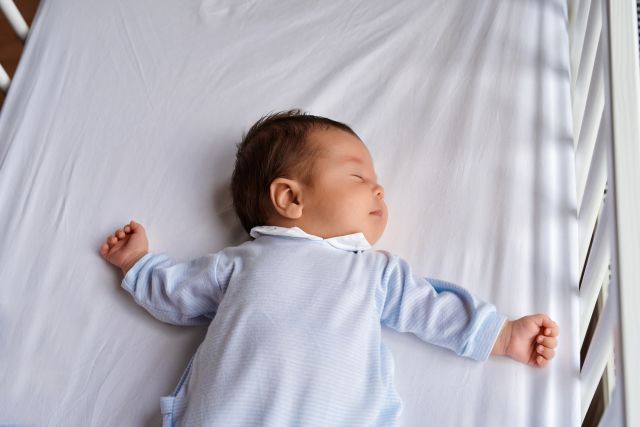Updated on February 29, 2024.
Each year about 3,400 infants under the age of one die from sudden and unexpected causes. In 2020, about 1,389 of these infant deaths were due to SIDS (sudden infant death syndrome), according to the Centers for Disease Control and Prevention (CDC). That could be an underestimate because investigators cannot always find the cause of death.
Find out what may be endangering your baby—and learn steps you can take to reduce the risk of SIDS.
SIDS risk factors
While some cases of SIDS-related death have no apparent cause, over 95 percent of them are associated with one or more risk factors. Many of these risk factors are preventable. They include:
- Smoking during pregnancy
- Age of mother under 20 years
- Late or no prenatal care
- Preterm birth or low birth weight
- Putting baby to sleep on their stomach
- Placing baby on a soft surface or in dangerous settings
- Sharing a bed with parents
- Overheating
Ways to reduce SIDS risk
If you have a baby under the age of one (or are about to have a baby), there are several measures you can take to help reduce the risk of SIDS:
Set your baby to sleep on their back. Generations ago, babies slept on their stomachs—and the rate of SIDS was double that of today. In the 1990s, guidelines changed in favor of putting babies to sleep on their backs, rather than their stomachs or sides, which increase the risk of SIDS. Following the simple mantra “back to sleep” cuts the risk of SIDS by over 50 percent.
Co-room, don’t co-sleep. The American Academy of Pediatrics (AAP) released updated recommendations on SIDS prevention in 2016. Among the suggestions was to have your baby sleep in your room. This reduces their risk of SIDS by up to 50 percent. Just be sure they’re sleeping in an appropriate area, and not in your bed. Having baby sleep with you in your bed increases the risk of SIDS.
The safest option is to place a Consumer Product Safety Commission-approved bassinet by your bed, where baby is within arm’s reach but safely out of harm.
Remove everything from the sleep area. According to a study published in 2016 in the journal Pediatrics, about 91 percent of parents put their children to sleep with unsafe items such as bedding, bumper pads, pillows, stuffed animals, and sleep positioners.
Even supposedly “safe” bumpers have been associated with infant deaths. Between 2011 and 2017, 1,150 infant deaths were linked to soft objects, loose bedding, bumper pads, and other objects that could cause suffocation, according to data from the Centers for Disease Control and Prevention published in 2021 in Pediatrics. Use a simple, fitted sheet to cover the mattress.
Unless there’s an item your pediatrician explicitly says you must have in the crib, leave it out. Manufacturers who sell these items are taking advantage of parents’ fears and countering the guidance from the AAP.
Also be sure the sleeping surface is flat and firm. That means the mattress should quickly return to its original shape when pressed.
Use a wearable blanket and swaddle only up to a certain age. Wearable blankets are safer than loose blankets in the crib. If you’re swaddling your infant, make sure to only place them on their back. As soon as your baby shows any signs of attempting to roll, stop using the swaddle, which can become a potential risk factor once your baby is more mobile.
Consider a pacifier. If your baby likes the soothing effect of a pacifier at bedtime, it's ok to use. It's not fully understood why, but research has shown that pacifiers at bedtime can reduce the risk of SIDS. Just be sure not to use a pacifier “leash,” which could become a suffocation hazzard.
Breastfeed. Nursing or feeding your baby pumped milk lowers the risk of SIDS, among other benefits. While the AAP recommends breastfeeding for six months, one study published in Pediatrics in 2017 found that risk of SIDS decreases with breastfeeding even for two months. The longer your baby is exclusively breastfed without adding formula or solid food, the lower their risk of SIDS may be.
While many parents can do this, others cannot for a variety of reasons. Even if you can’t breastfeed for the longer term, a little bit is better than none.
Don’t smoke or vape. Smoke exposure during pregnancy and after birth are major risk factors for SIDS, particularly when baby shares a bed with an adult smoker—even if that person doesn’t smoke in bed.







